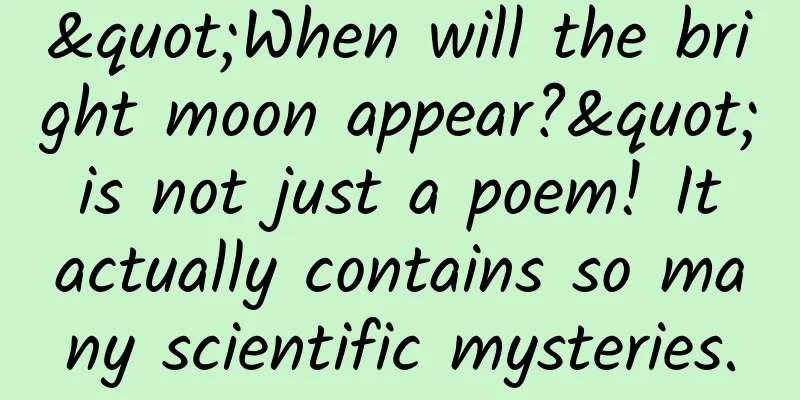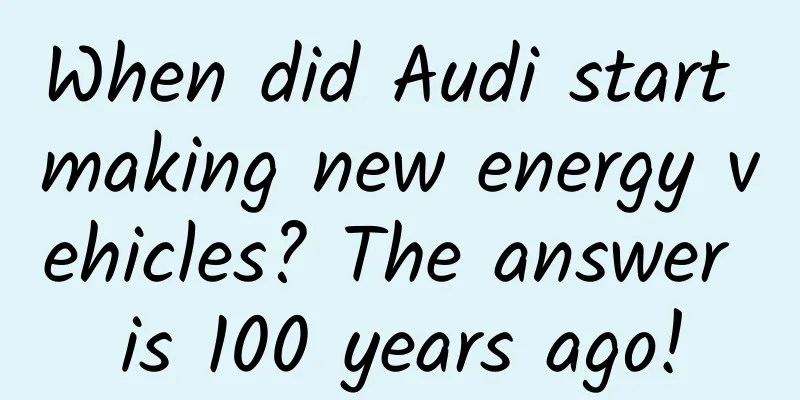"When will the bright moon appear?" is not just a poem! It actually contains so many scientific mysteries.

|
"When will the bright moon appear? I raise my cup to ask the sky. I wonder what year it is in the palace of heaven. I want to ride the wind to go back, but I am afraid that the jade buildings are too cold up there. I dance with my shadow, but it doesn't seem like I'm in the human world. Turning the red pavilion, lowering the beautiful window, shining on the sleepless. There should be no hatred, why does the moon always appear full when we are apart? People have joys and sorrows, separations and reunions, the moon waxes and wanes, this has always been difficult to achieve. I wish you a long life, and we can enjoy the beauty of the moon together even though we are thousands of miles apart. " More than 900 years ago, Su Shi expressed his feelings through the moon and left behind the poem "Water Melody: When Will the Bright Moon Appear?", which has become a poem we often recite. Little do we know that this lyrical masterpiece also contains rich scientific knowledge. When will the bright moon appear? The fragments of a planet that hit the Earth formed a celestial body 4.6 billion years ago, the Earth was in the process of being conceived, and the solar system was still in the chaotic solar nebula stage. Around the young sun, dust and massive rocks continued to condense, collide, and accrete, and some of the matter in the nebula began to form planets and satellite systems orbiting the sun. About 4.45 billion years ago, the Earth, the third largest planet closest to the sun, encountered an unprecedented disaster. A planet similar in size to Mars, Theia, came quickly, and because the orbits of the two planets intersected, a huge collision was inevitable. This was a shocking collision, which threw the mantle and crust of the two planets into the nearby space. When the remaining impacting planet changed its orbit and left, a large number of planetary impact fragments remained near the Earth. As time passed, the material surrounding the Earth gradually aggregated and began to form an independent celestial body. Drinking wine and asking the sky: Blue light has a short wavelength and is more easily scattered When the weather is clear, the sky we see will appear blue. This is because when sunlight hits the earth's atmosphere, it collides with gas molecules and scatters, and the light propagates in all directions when scattered. Since the wavelength of blue light is shorter than that of red and yellow light, it is easier for them to interact with gas molecules in the air and thus be scattered more easily. The color of the sky is also affected by the thickness of the atmosphere. For example, at sunset and sunrise, the angle of the sun's rays is lower and it needs to pass through more atmosphere. This results in more scattering and a longer light path, making red and orange light more easily scattered, while blue light is filtered out. Therefore, we see the sky appear red, orange and yellow at this time. In addition, on cloudy days or when there are clouds, the color of the sky becomes darker because the clouds scatter all colors of light. In this case, the color of the sky may appear gray or white. In general, although blue is the color of the sky we usually see, it is actually not the only color. What year is this evening? The mass of an object can affect time Newton's absolute view of time and space holds that: "absolute, true and mathematical time is passing by itself, and due to its nature it passes evenly and independently of any other external things." "What year is this evening?" Su Shi's words transcend Newton's absolute view of time and space, and coincide with Einstein's view of time and space in the theory of relativity. Einstein tells us that time and space are not absolute, but complementary and inseparable. The mass of an object can affect space and promote the generation of gravity, so the mass of an object can also affect time. Therefore, in different gravitational fields, the flow rate of time is also different. There is a time error between the surface of the earth and the satellite revolving around the earth. The time on the earth is slower than the time on the satellite, but the difference in the flow rate of time is very small. It’s lonely at the top: The higher the altitude in the troposphere, the lower the temperature We know that the higher the altitude, the lower the temperature. But this common sense is conditional. Only in the troposphere in the atmosphere, the higher the altitude, the lower the temperature. For every 1,000 meters increase in altitude, the temperature drops by about 6 degrees Celsius. This is because the troposphere warms up by absorbing electromagnetic waves radiated from the ground. The hot air close to the ground expands and rises, and the cold air in the high altitude contracts and falls, thus generating convection movement, which is why this layer is called the troposphere. Unlike the troposphere, the situation in the stratosphere is just the opposite. In the stratosphere, the higher the altitude, the higher the temperature. This is mainly because there is an ozone layer in the stratosphere, which can absorb ultraviolet rays in solar radiation. Therefore, the closer to the sun (the higher the altitude), the hotter it is. Unlike the Earth, the Moon has almost no atmosphere. Due to the lack of an atmosphere, the temperature on the Moon can reach 127 degrees Celsius in direct sunlight during the day, and can drop to minus 183 degrees Celsius at night. Why is it that the moon always appears full when we are parting? The sixteenth day of the lunar calendar is the most common time when the moon is full. There is one day in a lunar month when the moon is at its fullest, which is called "望". However, the roundness of "望" varies slightly from month to month. This is because the moon's orbit around the earth (white path) and the earth's orbit around the sun (ecliptic) are not in the same plane. According to the lunar calendar, the "望" when the moon is at its fullest can occur as early as the night of the 14th day of the lunar calendar and as late as the morning of the 17th day of the lunar calendar. It is most common on the 15th and 16th day of the lunar calendar, with the 16th day being the most common. Therefore, there is a folk saying that "the moon on the 15th day is full and the moon on the 16th day is full". From 2021 to 2023, for three consecutive years, the Mid-Autumn Festival will be "the moon on the 15th day is full and the moon on the 15th day is full", and in the Mid-Autumn Festival of 2024, it will return to "the moon on the 15th day is full and the moon on the 16th day is full". The moon waxes and wanes: Caused by lunar phases and lunar eclipses The waxing and waning of the moon can be divided into two categories: one is the change of the moon phases, and the other is a lunar eclipse. The moon itself does not emit light. The moonlight we see is the reflected light from the sun. The reflected light has a reflection angle. When the sun, the earth, and the moon are in different positions, we will see changes in the phases of the moon. Because of the existence of the yellow-white angle, not every lunar month will have a solar or lunar eclipse. A solar or lunar eclipse will only occur when the moon, the sun, and the earth are in the same straight line, and the moon is near the intersection of the two planes. On the full moon day of the lunar calendar, the moon moves to the opposite direction of the sun. At this time, if the center of the earth and the moon are roughly in the same straight line, the moon will enter the earth's umbra, resulting in a total lunar eclipse. If only part of the moon enters the earth's umbra, a partial lunar eclipse will occur. So there are two types of lunar eclipses: a total lunar eclipse and a partial lunar eclipse. (The author Yang Hongbing is a physics teacher at Nanjing No. 13 Middle School) |
>>: What is Chaoshan? Fresh and lively!
Recommend
Why are vaccines given in the arm instead of the buttocks? How many "vaccine marks" do you have on your arm?
Expert in this article: Li Xue, Peking Union Medi...
Crashing into fire trucks, police cars, and private cars, should Tesla be blamed for the autonomous driving accidents?
Musk has been having a headache recently becaus...
What’s Worth Buying APP Product Analysis
With the emergence of new industry trends such as...
Jobs' invisible achievement: Improvement of IPS display technology
Many people know about Jobs' innovative and s...
BYD: BYD has applied for more than 48,000 patents worldwide
According to recent news, BYD released an announc...
Tiangong Space Station: Opening a new era of Chinese "space settlement"
On December 9, 2021, Wang Yaping (left) and Ye Gu...
Kaola.com Product Analysis Report
Kaola.com focuses on the cross-border e-commerce ...
Carbon Neutrality Industry Report
Carbon Neutrality Industry Report Resource Introd...
How to get users to actively download your product?
What does scenario-based app promotion mean? It i...
His and Her Feast, Traveling Through 3,400 Years
Produced by: Science Popularization China Author:...
A highly profitable virtual product project, earning 300 yuan per order
There are more and more virtual products being so...
How can medical and health products be accurately placed on Xiaohongshu to achieve high ROI?
For brands, Xiaohongshu has become an important p...
Qin Zhiqiang: How to sell virtual products and public account SEO on WeChat, and easily earn 10,000 yuan a month by working part-time at home
Two years ago, knowledge payment became popular, ...
Attention! WeChat keyboard starts second round of internal testing to prevent eavesdropping and protect privacy
When we enter passwords on our phones, it is easy...
One-click information capture, is the high-dimensional light field detector so powerful?
Produced by: Science Popularization China Author:...

![[Popular Science of Chinese Military Technology] Do the rapidly evolving humanoid robots dream of going to the battlefield?](/upload/images/67f23e973f6ce.webp)







